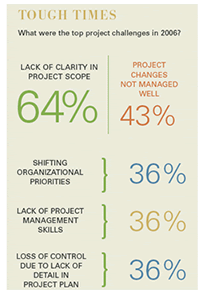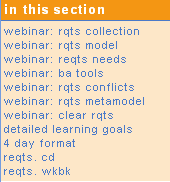Requirements Gathering
 Two-thirds of all application system defects can be
traced to incomplete,
inaccurate, or missing requirements. This seminar, based on a research project
including over 50 companies, offers practical techniques to get
requirements right. The study showed a potential
hundred-fold economic return on the effort expended to improve
requirements definition.
Two-thirds of all application system defects can be
traced to incomplete,
inaccurate, or missing requirements. This seminar, based on a research project
including over 50 companies, offers practical techniques to get
requirements right. The study showed a potential
hundred-fold economic return on the effort expended to improve
requirements definition.
Is this how your people are gathering requirements?
-
Scope has careened wildly out of control
because of their inability to uncover true needs and to hear when
requirements are not clear or plain, are ambiguous,
are vague, or are uncertain.
- They are wasting time because of an inability to distinguish true needs from
wants.
- They are wasting effort because of an inability to manage scope
creep and an inability to see wasted
processes?
- Chaos is reigning because your
people don't have a toolkit of processes to find, resolve, and refine
requirements. (Resolve conflicting
needs and wants.)
Signs that your Requirements Gathering
Process May Be "Broken"
- Huge cost overruns
- Spending more money correcting than finding defects.
- Spending mass sums on defect detection and correction.
(If you’re not doing the right thing, it really doesn’t matter how well you’re doing it.)
- Iterative or ad hoc processes, guidelines, and training
- Your staff is fighting over opinions. Nobody knows
the facts.
- Your people are never done gathering reqts.
- Your staff is constantly rehashing the best solution
because they have no method to resolve conflicting trade-offs;
your people don’t know how to determine the “best” solution.
- Your people are finding true reqts closer to end of project at the worst possible time.
- Your people are
"technology-crazed." If they have a
"hammer" they see only
"nails." Your people are taking what they are already doing and
superimposing it on the problem.
- Your people's solutions are technology-based not problem-based.
- The users' needs are tainted by the
technology available to use. You may
need to decode your users' needs. (True needs are those that are phrased in such a way as they cannot be addressed with technology.)
- Your people are not testing requirements,
therefore, requirements are unclear or broken.
- Your staff is asking too detailed questions
and have completely misunderstood the problem.
- Management is not committed to the
requirements gathering process.
What are your people actually going to do in this
course?
- Deconstruct why requirements are often invalid.
- Identify sources of poor requirements.
- Distinguish
needs from wants.
- Help customers verbalize
unknown needs.
- Identify, diagnose, parse and
reform errors in requirements.
- Calculate true needs tied to the
mission and eliminate wasted processes.
- Develop standards for good
requirements.
- Minimize information loss, misunderstanding,
and ambiguity.
- Use a six-phased procedure for developing requirements.
- Practice models to interactively improve rapport, interview techniques, and question
elicitation strategies via NLP
metamodeling strategies.
 Sample this course: select any of the WEBinars listed under "in
this section" top-left above.
Sample this course: select any of the WEBinars listed under "in
this section" top-left above.
Projects related to this course:
For an electronic design automation company in Oregon, Steve showed members of a team a way of computing undiscovered requirements from existing missions and
processes, by utilizing a special matrix. One of those individuals applied these techniques for 30 minutes and saved the customer over $11,800,000.
For a Federal Branch chief, Steve "installed" the capability for that person to think and interact generally when before they were only able to interact in detailed specifics, via coaching and NLP
(Neuro Linguistic Programming), thus improving communication with more senior managers.
For a Federal Government Agency, Theresa and Steve took their requirements gathering process
in a completely new direction, from solution orientation to
assuring the meeting of true customer needs, by implementing a 6-step requirements gathering process.
Major tools included a needs derivation based on mission and
information elicitation strategies.
Course Outline:
This course is typically held in a 4-day session. The first 2 of the 4 days is an
interactive tutorial with exercises sharing a new process model
for requirements gathering and implementation.
- Tutorial and training
- Live demonstrations
- Directed
practice and coaching using real company requirements
The remaining 2-day session is broken into 4 equal 1/2 day
sessions, having the following
structure:
- The Requirements Mission - Process - Requirements (MPR)
model to calculate true needs
- The Rapport - Process - Interview - Process - Rapport
(RPIPR) interviewing model to minimize defects during
information gathering
- Elicitation strategies to minimize ambiguity
and increase focus, especially for users who don't know what
they need. The answer to "I'll know it when I see
it" (reduce requirements ambiguity)
- Active listening, demonstrated understanding, and
integration of all previously learned models
Also included:
- Detailed surveying and optional interviewing of participants for course tailoring
- 4 day intensive
seminar
- Substantial morning,
daytime, noon, and evening individual "Navigating The Obstacle Course
Coaching"
- Detailed seminar
workbook
- Follow-on WEBinars to
integrate performance on the job
- Free digital CD: All
PowerPoint slides plus full audio transcript
|